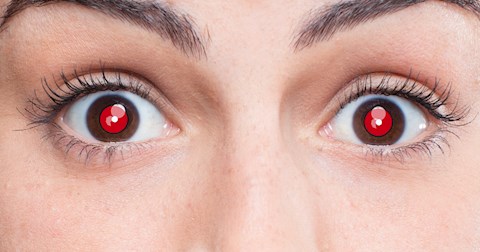>
#photography
,
#eyes
,
#red-eyes-effect
,
#science
,
#interesting-facts
,
#general-knowledge
>
Why do our eyes turn red in flash photos?
Anonymous
Mar 26, 2020
Why do our eyes turn red in flash photos?
When an animal’s eyes glow green or yellow in the headlights, it’s a sign of good night vision. A special layer of cells in the back of the eye reflects light back like a mirror. Some of that light is reabsorbed by the eye, letting a deer, raccoon, or opossum see better in the dark. But human eye-glow doesn’t lead to anything but weird-looking birthday photos—Mom, Dad, and little Billy leaning over the candle-studded cake, all with gleaming red eyes. If a camera steals your soul, perhaps a flashbulb replaces it with something demonic.

1 answer
Sort By
Anonymous
Mar 26, 2020
Actually, the creepy red-eye effect is due to something a lot more benign—those pesky blood vessels in the back of the eye.
The ingredients for the red-eye effect are simple: a dark night or dim room, a camera with a flash, and a person willing to look straight into the lens (or better yet, at the flash itself).
When the flash goes off, light streams through the pupil, the eye’s adjustable porthole. The eye’s lens focuses the light on the light-collecting retina in the rear, which is fed by a crisscrossing network of blood vessels. When the burst of white light hits the vessels, they absorb light from the blue-green end of the spectrum, but reflect back red. Ruby-red light shoots back out through the eye and into the camera lens. Presto: the possessed effect.
In a dim room, our pupils are already open wide. And because of the way our eyes’ iris muscles must bunch up to contract the pupils, they don’t shut quickly. So when the flashbulb goes off, the pupil doesn’t have time to shrink much—and the bright, focused light shoots straight through. Outdoors in the daytime, pupils are already at their most constricted, so a flash photo won’t show red eyes.
Light blue or gray eyes often glow most crimson in photos, since pale irises have less pigment to block light. Many cameras reduce the red-eye effect by setting off several quick flashes before actually taking the picture. That way, the pupils have time to constrict before the final flash.
To avoid red-eye, try taking pictures with more room light and no flash. In a camera with an adjustable flash, point the bulb at a white ceiling or wall rather than at the people you’re photographing.
0